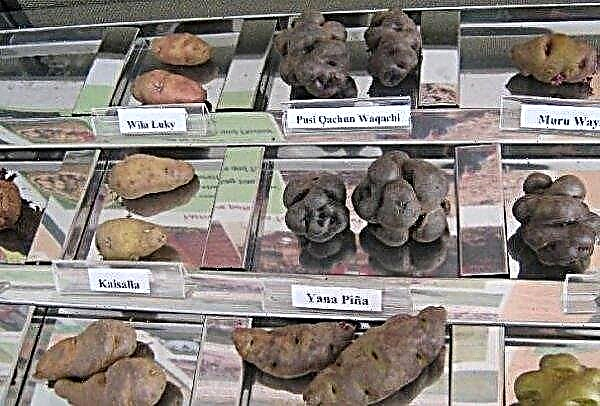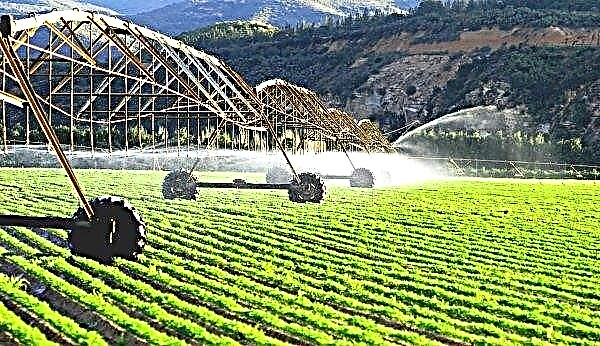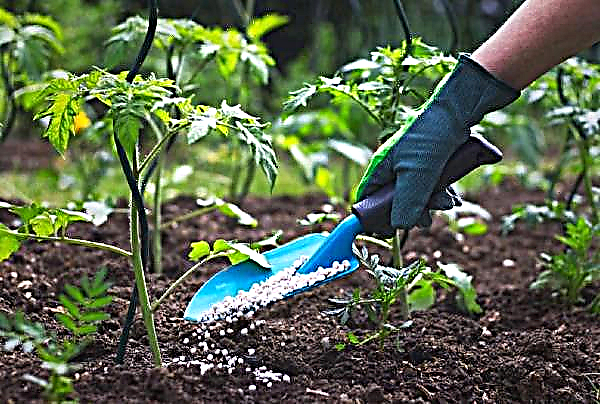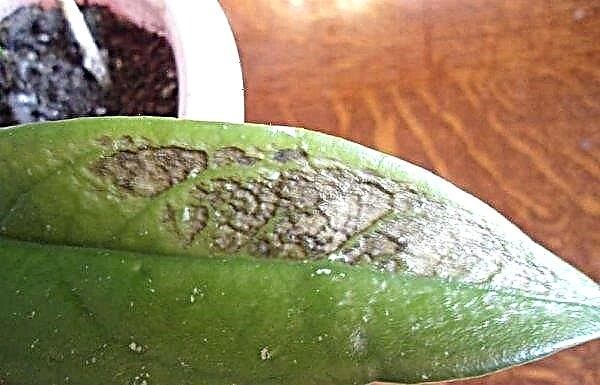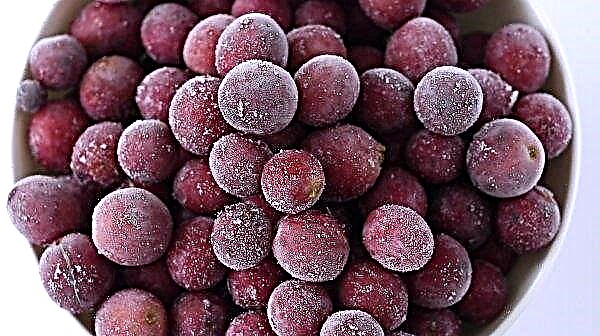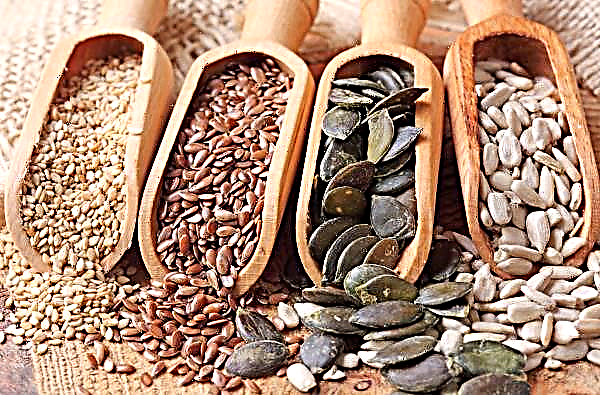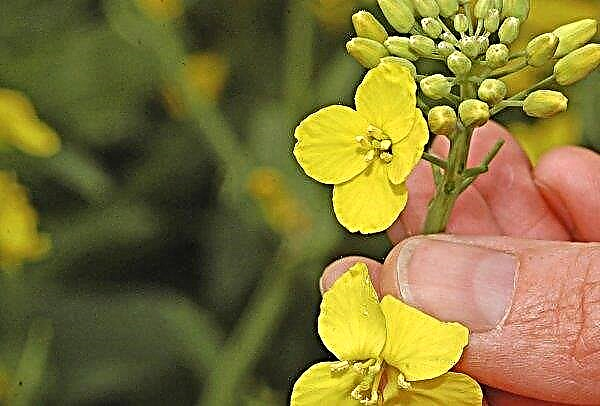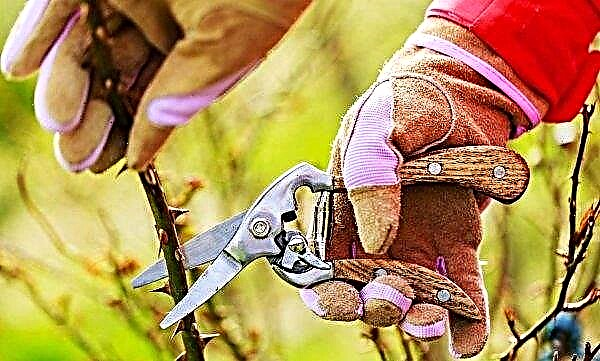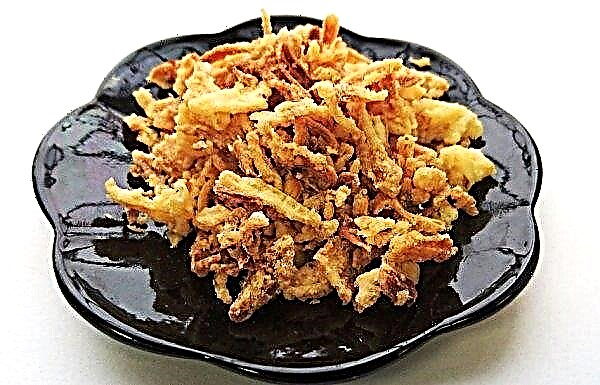Few people do not like tomatoes, and in the warm season housewives regularly put fresh tomato salads on the dining table. But I especially want to try a fragrant tomato in early summer, so gardeners plant early and ultra-early varieties. In this article we will get acquainted with the early-ripe variety of Yamal tomatoes, learn how to grow seedlings from its seeds and get an excellent harvest.
Grade description
General characteristics of the tomato variety "Yamal":
- tomato of determinant type (with a limited growth point), with a standard bush;
- height - 50–55 cm, due to stunting, it can be grown without garter;
- the bush has medium branching, stepsons are formed in the sinus of each leaf, the distance between the leaves is 10-15 cm;
- has a good yield, an average of 8.5 kg per 1 m²;
- fruits of bright red color, roundish (sometimes with a pronounced ribbing), 4-chamber, without a green spot in the upper part;
- 5 to 6 tomatoes are tied in each brush. Provided that the Yamal tomatoes will be grown in 3-5 stems, from 5 to 15 fruit brushes will form on the plant;
- the taste of tomatoes is traditional, with a slight acidity;
- the fruits tolerate long-distance transportation due to the dense pulp and elastic skin;
- the weight of the tomatoes tied in the first brush is quite large, 150–200 g. In all subsequent brushes, the weight of the tomatoes becomes smaller and does not exceed 80–120 g;
- early ripe variety, begins bearing fruit in 90–105 days after emergence of sprouts from the soil;
- to obtain early production, Yamal seeds are sown for seedlings 1.5–2 months before the expected date of planting in open or closed ground. To get an extra early harvest, Yamal is grown in greenhouses, greenhouses and film tunnels. In central Russia, the variety grows well in open ground;
- It has good resistance to major solanaceous diseases, such as late blight, alternariosis and others. Due to this quality, they can be planted in a thickened planting.
Photo gallery
Advantages and disadvantages
- The advantages of the variety include:
- early ripening;
- simultaneous ripening of the crop on all hands;
- high and medium yields;
- quick yield;
- does not require garter;
- undemanding to growing conditions;
- resistance to major diseases of tomatoes.
- The disadvantages of the variety:
- heterogeneity of the crop, the mass of fruits in the first brush is 150-200 g, in all subsequent smaller - 80-120 g;
- Quickly finishes fruiting;
- flesh with sourness, as in many early low-growing varieties.
How to grow tomato seedlings yourself
Methods of growing tomato seedlings:
- Sow tomato seeds in rather large collective containers (boxes), and then later transplant each seedling into separate pots (pickle).
- If the plant grower has enough space and pots (or multi-chamber cassettes for seedlings), the second method is to sow individual plants in individual containers or cells. It is important that such a container is clean and free from the diseases of the previous "residents", therefore it is necessary to carry out disinfection (treatment with hot water or hot steam).
Did you know? Green tomato fruits, like green potatoes, contain a poisonous substance - solanine. It is difficult for a person to poison with solanine, since for severe intoxication it would be necessary to eat half a bucket of green tomatoes, but you should treat them with caution.
Optimum timing for sowing
The timing of planting tomato seeds should depend on the conditions that the gardener can provide for young plants. If the gardener has a film tunnel or a greenhouse in which seedlings can be planted before the onset of May 15, then seeds can be sown early, starting work on February 20 and continuing to sow until mid-March. It usually takes about 5–8 weeks to produce tomato seedlings. Thus, it is easy to calculate that if it is intended to plant tomatoes in the soil after May 15, the seeds are best sown around March 15.
It usually takes about 5–8 weeks to produce tomato seedlings. Thus, it is easy to calculate that if it is intended to plant tomatoes in the soil after May 15, the seeds are best sown around March 15.
Did you know? There are more than 10 thousand tomato varieties that differ in bush height, color, shape and size of the fruit. Tomatoes can be colored red, yellow, orange, green, white, pink, black, brown or purple. There are also striped tomatoes: a yellow stripe on a red background, a green stripe on an orange background and other variations.
Tomato seedlings are best planted in a permanent place when they reach a height of 15-30 cm. This is due to the fact that plants with an overgrown stem are more difficult to adapt to new conditions. It often also happens that seedlings obtained from seeds sown too early (for example, in January) are elongated, thinned, have sluggish and weak shoots, and, as a result, low productivity.
The soil
The containers are filled with special soil for seedlings purchased in seed shops or with soil mixed independently with ground peat (to increase hygroscopicity). At this stage, it is important not to add fertilizer to the ground, it can harm young and immature seedlings. Potted soil is well moistened before sowing. Before filling the pots with soil, it must be decontaminated. At home, this is most conveniently done by calcining the earth in the oven at high temperature:
At home, this is most conveniently done by calcining the earth in the oven at high temperature:
- The soil is scattered on the baking sheet with a layer of not more than 5 cm in thickness.
- Baking trays with soil are put in the oven, close the door, and then set the temperature control to +180 ... + 220 ° C.
- Calcined for 30–35 minutes.
- The cooled soil is scattered in pots.
Important! If the seeds are sown in individual pots, then it is advisable to lay a drain on the bottom of each, which will facilitate the outflow of excess moisture and prevent the root system of tomatoes from rotting.
Capacity for growing
Tomatoes can be grown:
- in half-liter plastic glasses;
- in peat pots;
- in special seedling plastic cassettes;
- in peat tablets;
- in common seedlings, followed by a dive.
 All of the above containers are great for growing tomatoes. Small restrictions exist for peat tablets. Peat tablets of the largest diameter are purchased for growing tomato seedlings, but this volume is not enough for the plant for a long time. After the appearance of 4 real leaves, the tomato needs to be transplanted into a pot with a volume of at least half a liter. To do this, the plant, together with a peat tablet (looking like a glass of peat), in which its root system is located, is transferred to a pot and covered with soil.
All of the above containers are great for growing tomatoes. Small restrictions exist for peat tablets. Peat tablets of the largest diameter are purchased for growing tomato seedlings, but this volume is not enough for the plant for a long time. After the appearance of 4 real leaves, the tomato needs to be transplanted into a pot with a volume of at least half a liter. To do this, the plant, together with a peat tablet (looking like a glass of peat), in which its root system is located, is transferred to a pot and covered with soil.
Of the common seedling boxes, tomato seedlings are also dive at the age of four true leaves for individual containers. At the bottom of each planting pot, container, or cell, there must be an opening to drain excess fluid. If there is no hole, the roots will rot due to excess moisture, and the tomato will begin to hurt or even die.
Seed preparation
Thanks to the preliminary treatment of seeds, young seedlings develop better and become resistant to dangerous diseases and pests, which further increases productivity. Pretreatment protects germinating seeds from pathogens and pests transmitted from the parent tomato to the seeds or in the soil. Seeds are treated to disinfect and to stimulate further growth. Many gardeners use a pale pink manganese solution as a disinfectant. Seeds are soaked in a potassium permanganate solution for a period of half an hour to an hour, after which they are thoroughly washed under running water. Further, thus disinfected seeds can be treated with any growth stimulants. You can also purchase special preparations for seed treatment ("Tiuram", "Carboxin" or "Mankozeb"). These substances protect young seedlings for some time, but only against fungal diseases.
Seeds are treated to disinfect and to stimulate further growth. Many gardeners use a pale pink manganese solution as a disinfectant. Seeds are soaked in a potassium permanganate solution for a period of half an hour to an hour, after which they are thoroughly washed under running water. Further, thus disinfected seeds can be treated with any growth stimulants. You can also purchase special preparations for seed treatment ("Tiuram", "Carboxin" or "Mankozeb"). These substances protect young seedlings for some time, but only against fungal diseases.
Undiluted aloe juice and honey diluted in a small amount of water are used as biological growth stimulants. Seeds are soaked in these liquids for 10-12 hours, after which they, without washing, are immediately sown in the ground or placed in a refrigerator for hardening.
Important! The use of biological growth stimulants (honey, aloe juice) cannot harm the seeds. And the chemically active substances used for seed disinfection must be used in compliance with the dosage specified in the instructions for the preparations.
You can also use the growth stimulants that seed stores offer. Such growth stimulants as Emistim, Baikal, Epin have proven themselves well.
Sowing seeds
How to sow tomato seeds:
- Before sowing, in each pot the surface of the soil is leveled and watered abundantly. After watering, pots with soil are left for 2-3 hours in order to remove excess moisture.
- In the center of each individual container, a deepening of about 0.5 cm depth is made, where 2 seeds of tomatoes are placed. The distance between these seeds is at least 1 cm. 2 seeds are needed for safety, always 1 or 2 plants will sprout. If 2 seedlings grow in the pot, one of them will be gently plucked out later (not torn out). This is done after 2 true leaves appear on the plants. A weaker plant is usually removed.
- If the seeds are sown in common seedling boxes - they are laid out on previously drawn furrows with a depth of 0.5 cm with a distance between seeds of 1.5–2 cm. If there are few seeds, the distance between them can be increased (from 5 to 10 cm), this is only will benefit young plants.
- Sown seeds are covered with soil and lightly tamped with a palm. Only one sort of tomato is sown in one furrow; opposite the furrow, a number is written on the side of the box. On the label (hereinafter attached to the box) record the number of furrows and the name of the varieties that are sown in them.
- When the sowing is over, each pot or common box for seedlings must be covered with plastic wrap and put in a warm place for germination.
- A label is attached to each individual container, which indicates the name of the variety and the date of sowing.
- The first seedlings appear from the soil on the 5-7th day after sowing. Immediately after the appearance of the first sprouts, pots and boxes are rearranged on window sills or on a seedling table equipped with a phytolamp for lighting plants.

Seedling Care
For seedlings grown indoors, proper care is necessary:
- After the tomatoes have several real leaves (3-4 leaves, with a plant height of about 10 cm), they are transplanted into larger containers. Of the common seedling boxes, picking is carried out in this way: young plants are carefully removed from the soil and transplanted into individual pots. Seedlings, originally sown in individual containers, are transplanted into larger pots by the method of careful transshipment along with a lump of earth.
- On windowsills of windows looking north, small tomatoes also need additional lighting. Such illumination can be organized by simply installing a conventional table lamp with a fluorescent light (housekeeper) on the windowsill and directing the light to the seedlings. In February - March, tomatoes need additional lighting during the morning and evening hours. In the morning, the seedlings are turned on in the interval from 8.00 to 10.00, in the evening from 17.00 to 20.00.
- After the appearance of 3 and 4 of this leaf - it is advisable to feed young seedlings on the leaf. This procedure is very important, since fertilizers were not initially laid in seedlings. To do this, you can use growth stimulants (Epin, Emistim) or a special mineral top dressing for seedlings. All these drugs can be bought at any horticultural center. At this stage, it is better not to use home-made fertilizers from bird droppings and stuff, the probability of burning immature plants is too high.

Watering
Watering seedlings is carried out only when the topsoil is well dried. Watering should be moderate and remember that a large amount of moisture in the soil will lead to the development of fungal diseases. In February - March, seedlings are by no means watered on a leaf, only under the root. An exception is made only for foliar application.
Did you know? In 1 g of tomato seeds - 250 pieces. From one large, lettuce tomato, you can collect up to 5 g of seeds. To provide yourself with seeds of your favorite variety, it is enough to pick one ripe tomato and lay it on the window. As soon as the fruit begins to deteriorate, it is necessary to cut it in half and select the seeds. They, along with tomato juice, put for fermentation for several days, then washed in clean water, filtered and withtub. They do not lose germination for 5-6 years.
Water for irrigation should not be cold, the most acceptable in this case is room temperature. It is most convenient to determine the correct temperature as follows - dip your hand in water for watering, if the temperature is comfortable for the body, then it is suitable for watering seedlings. It is undesirable to water young seedlings with chlorinated tap water. It is best suited for this purpose melt or rain water, but if it is taken from nowhere, the tap water must be defended for a day and only after that it can be used for seedling irrigation.
Temperature mode
The temperature in the room where the seedlings are located should not fall below +18 ° C or rise above +25 ° C. At low temperatures, the soil molds, the root system of tomatoes rots, and there is a great chance of a disease such as a black leg. This disease can destroy all seedlings in one day.
The first sign of the development of the "black leg" is the blackened and thinned stalks of seedlings in the area of their contact with the ground. In this case, it is urgent to stop watering and sprinkle the soil and seedlings with wood ash sifted through a fine sieve.
High temperatures in the room contribute to the rapid growth of aboveground mass and excessive stretching (thinning) of the stems. In the conditions of growing seedlings indoors, without proper sunlight, such plants become pale, too tall and thin.  Even sown in February, such weak seedlings, when planted in open ground, will be sick and adapt for a long time. As a result, plants sown a month later will yield an earlier and more abundant crop than February seedlings grown in room heat.
Even sown in February, such weak seedlings, when planted in open ground, will be sick and adapt for a long time. As a result, plants sown a month later will yield an earlier and more abundant crop than February seedlings grown in room heat.
Seedling hardening
With the advent of spring, when the street temperature rises and becomes stable (not lower than +15 ° C), it is time to begin hardening of tomato seedlings. To do this, the pots and drawers are taken out to the balcony or to the street at first no longer than an hour. Every day, the duration of hardening of seedlings on the street increases, and by the end of the first decade it stretches for a whole day. After that, seedlings are brought into the room only at night, and in the morning they are put out again for adaptation and hardening.
Hardening of tomato seedlings begins no later than 2 weeks before the expected date of planting the plants in a permanent place.
Important! The place for arranging pots with seedlings must be chosen so that direct sunlight does not fall on young plants and tomatoes are protected from the north winds. Most preferred is diffused sunlight and partial shade to prevent leaf burns..
When to plant seedlings in a permanent place
When planting seedlings, you should adhere to some recommendations:
- Planting tomatoes in open ground begins when the earth warms up well and its temperature is not lower than +15 ° C at a depth of 40 cm. With colder ground, plant roots cannot absorb nutrients from the soil.
- Planted in too cold land, tomatoes become susceptible to various fungal diseases. The root system of such plants develops slowly; the entire excess of nutrients passes from the root system to the aboveground green mass. That is, a tomato planted in cold soil will later have a lush and beautiful bush, a weakly branched root system, and a rather weak yield.
- According to popular beliefs, tomatoes can be planted in the ground when full-grown, mature leaves appear on the birches. At this time, the soil is already warm enough in the spring sun, you can start planting tomatoes. In the southern regions, gardeners focus on singing cicadas. When the evening is filled with loud trills of cicadas, it's time to plant tomato seedlings.
- If the gardener involves planting young tomatoes under a film (in a greenhouse or film tunnel), then in the southern regions, you can start transplanting after April 15, and in colder regions - from May 1.
 In any case, when deciding on planting tomato seedlings in open ground, it is necessary to take into account the weather, since spring can be both early and warm, and cold. In different climates, the conditions for growing tomatoes in open ground can vary significantly.
In any case, when deciding on planting tomato seedlings in open ground, it is necessary to take into account the weather, since spring can be both early and warm, and cold. In different climates, the conditions for growing tomatoes in open ground can vary significantly.
Yamal tomatoes are a low-growing variety, so they are planted according to one of these schemes:
- In two lines - with a distance between rows of 40 cm, and a distance between plants in a row of 25-30 cm. A path with a width of at least 60 cm is laid every two rows. The plants in the rows are staggered relative to the tomatoes of the next row.
- In four lines - with the above distance between rows and plants. With this planting pattern, a path for a gardener, at least 1 m wide, is laid every four rows. Tomatoes in rows are staggered relative to the tomatoes of the neighboring row.
 Experienced growers recommend arranging tomato rows from south to north, this arrangement contributes to good sun exposure of plants and earlier ripening of fruits.
Experienced growers recommend arranging tomato rows from south to north, this arrangement contributes to good sun exposure of plants and earlier ripening of fruits.Did you know? In cooking, tomatoes are used in various forms: fresh, stewed, fried, boiled, as an ingredient or the basis of first and second courses, sauces, in the form of preservation or pickles, as well as in a dried and dried state. Some lovers of exotic even make jam from green tomatoes.
How to care for tomatoes in the open ground
In order for tomatoes to grow healthy and give a plentiful harvest, they must be looked after throughout the vegetative period. Tomato care consists of: regular watering, trimming stepchildren, systematic treatments with drugs for diseases and pests, loosening the soil in the root layer.
Watering
When growing tomatoes, several types of watering are used:
- Water is delivered to the roots of the plant along canals, shallow grooves located along the beds. Watering ditch should be located no closer than 10-15 cm from the tomato row. Water is poured into the irrigation ditch using a garden hose or a regular bucket.
- Drip irrigation tapes are laid out along the rows of tomato, with a spacing between irrigation holes of 25-30 cm. Usually, drip irrigation is connected to the water supply. If the site does not have a central water supply, drip irrigation can be carried out from a (drilled to a height of 1 m) water barrel.
- This method is used with a 4-line tomato planting scheme. In a longitudinal line along the garden bed, 2-liter plastic bottles with a cut off bottom are dug down with the neck so that two rows of plants grow on the left and right of the bottles. The distance between the bottles is from 40 to 50 cm. Twice a week, the bottles are filled with water for irrigation through the cropped top. Within 3-4 days, the water from the bottle is gradually absorbed into the soil and moisturizes it.
By the way, tomatoes can be grown without regular watering. This method is suitable for any temperate climate zone. In this case, when transplanting seedlings to a permanent place, at least half a bucket of water is poured into each well.  After planting, the soil under planted tomatoes is mulched (ripened leaves, humus, sawdust, dry grass) or simply sprinkled with dry soil. This method will not allow underground moisture to evaporate and it will be enough for the roots of the plant for almost the entire growing season.
After planting, the soil under planted tomatoes is mulched (ripened leaves, humus, sawdust, dry grass) or simply sprinkled with dry soil. This method will not allow underground moisture to evaporate and it will be enough for the roots of the plant for almost the entire growing season.
Important! In no case should you water tomatoes on a leaf, this can serve as an impetus for the onset of late blight or other fungal diseases.
Top dressing
Depending on the situation, different types of feeding are used.
Foliar
The importance of fertilizing tomatoes on a leaf is invaluable - nutrients enter directly into the plant tissue, this is especially important in rainy and wet weather, when young bushes are still weak, and the root system cannot yet provide the bush with all the nutrients. First of all, top dressing on the leaf helps to fill the deficiency of potassium, boron, magnesium, zinc and copper.
To prepare foliar top dressing, you can dissolve the following mineral additives in 10 l of water (optional):
- 1 g of potassium;
- 1 g of boric acid;
- 2 g of magnesium sulfate;
- 2 g of zinc sulfate;
- 0.5 g of copper sulfate.
Video: Topping tomatoes for a good harvest
You can also feed tomato bushes with ready-made complex fertilizer. For the entire vegetative period, it is necessary to perform 3-4 leaf dressings with pauses between them of 10-15 days. The first foliar application is carried out 10-15 days after transplanting the plants to a permanent place in the garden. Then the tomatoes are fed on a leaf every 15 days, during the formation of flower brushes.
So that the plants do not receive sunburn on the leaves, all dressings are carried out only in the evening or in cloudy weather. During flowering, tomatoes must be sprayed with a solution of calcium nitrate. For this, one spoonful of calcium nitrate is diluted in 10 liters of water. This procedure will protect the tomatoes from apical rot. You can also buy a ready-to-use complex of calcium chelates in agronomic shops, this is the most affordable form for plants. Do not mix fertilizers containing calcium with other mineral fertilizers. The interval between the spraying of these drugs is maintained (at least 4 days).
Root
The ingredients indicated in each recipe are designed to dissolve in 10 liters of water, the rate of liquid fertilizer for one plant is 1 liter. Feeding options:
Feeding options:
- 1 tbsp. spoon of nitrophosphate, 20 g of potassium;
- 0.5 l of bird droppings concentrate diluted with clean water in a ratio of 1:20, 20 g of superphosphate, 5 g of potassium sulfate;
- 1 tbsp. a spoonful of finished mineral fertilizers for tomatoes;
- 1 liter of fermented plant green slurry, 2 g of copper sulfate (1/3 teaspoon);
- 1 liter of fermented slurry from plant residues, 2 cups of ash, 2 tbsp. tablespoons of superphosphate, 2 g of copper sulfate (1/3 teaspoon).
Did you know? For a healthy male prostate, the presence of lycopene in the human body, which contains tomato fruits in abundance, is important. To prevent prostatitis, men need to include tomatoes in their diet as often as possible.
Stepson
Low-growing varieties of tomatoes do not need pinching. This procedure is even harmful for them, since it deprives the plant of the main part of the crop, which could be tied to remote lateral branches (stepsons). Therefore, the low and early tomato variety "Yamal" does not need to be deprived of stepsons.
Soil care
In order to get a good harvest, it is important to pay due attention to the soil:
- Every 7-10 days, beds of tomatoes need to be weeded, not allowing weeds to grow. Weed on a tomato bed not only occupies living space and draws nutrients from the soil, but also serves as a breeding ground for pests that gradually migrate to tomatoes.
- Weeding cleans the beds of weeds and loosens the soil, filling it with oxygen and making it permeable to moisture. It is indisputable that frequent weeding is tiring for a gardener, so many plant growers prefer to fill the bed with mulch or cover it with black and white agrofibre. Such a double-sided agrofibre completely covers the bed (black side down, white side up). The black side does not allow weed seeds to break out of the soil, and the white side does not allow the soil layer to overheat. Agrofibre also retains moisture in the soil, preventing it from evaporating under the influence of sunlight.
- As plant mulch, you can use last year's rotted leaves, humus, humus, sawdust of deciduous trees.
- The initial thickness of the mulching layer is made within 10-15 cm, but during the summer the layer of mulch has to be added. The need for bedding occurs because under the influence of the sun and moisture the mulch layer decomposes and settles. In this case, weeds can break through and grow through it. In addition to protecting the root layer of tomatoes, mulch is a gradually decomposing organic matter and feeds plants.
Tying bushes
Bushes "Yamal" are low, their height rarely exceeds 50–55 cm, they can be grown without tying to supports. But still, experienced gardeners are unanimously advised to tie up tomato bushes of any height. The benefits of tying tomatoes:
The benefits of tying tomatoes:
- This procedure protects plants from the occurrence of diseases, allows the wind to walk between tomato bushes and ventilate them.
- Tied tomatoes get enough light, this contributes to good fruit setting.
- Pouring tomato brushes do not lie on the ground, which means they do not rot and develop fungal diseases.
- It is convenient to spray bound plants with drugs for diseases and collect ripening fruits.
- Shrubs "Yamal" can be tied to low wooden pegs. A support of 50-60 cm in height is enough for them.
Did you know? The height of undersized dwarf tomato varieties does not exceed 15 cm, while lianoid varieties reach 5 m or more in the tropic.
Preventative treatment
In order to prevent the occurrence of diseases on tomato bushes, as well as the appearance of pests, it is necessary to observe some conditions:
- Regularly spray tomato plantations with fungicides and insecticides. Fungicides are drugs that block the development of fungi on plants and prevent the occurrence of infectious diseases. Insecticides are chemicals that kill or repel parasite insects from plants (Colorado potato beetle, leafworm, scoop, aphid). Carrying out chemical treatments of plants, it is necessary to carefully observe the dosage specified in the instructions attached to the drug.
- When planting tomatoes in a permanent place, you can not condense the planting pattern, thereby thickening the planting. In thickened plantings, the plants touch each other, the wind does not penetrate between their branches, but morning dew is perfectly delayed. All these factors create an excellent breeding ground for the development of fungal diseases.
- It is advisable to hold a garter of tomatoes to the supports. On untied plants, fruit brushes (with an ever-increasing weight of fruits) are gradually laid on the ground. Tomatoes in contact with the soil begin to rot, a suitable environment for the development of all kinds of bacteria and fungi arises.
- Do not irrigate tomatoes sprinkling on a leaf. In cold or cloudy weather, this is a direct path to the development of fungal diseases.
For the prevention of late blight on tomatoes, it is worth spraying tomatoes with furacilin.
Harvesting
Tomato fruits can be harvested, both in full ripeness and brown, they ripen quite successfully, being placed in a box. It is undesirable to delay the harvesting, as ripe and slightly colored tomatoes hanging on the bushes deplete the bush and do not allow other fruit brushes to develop and gain weight. The sooner the gardener removes the bulk of the crop from the bush, the higher the overall yield will be, since in a few weeks many new fruits will ripen on the same tomato. To grow seedlings of early Yamal tomatoes is not too difficult, but troublesome. Therefore, in order to achieve a good result, the gardener needs to sow the seeds on time and properly care for the fragile seedlings of tomato seedlings. The efforts of the grower will be rewarded with a tasty and plentiful harvest of early tomatoes.
To grow seedlings of early Yamal tomatoes is not too difficult, but troublesome. Therefore, in order to achieve a good result, the gardener needs to sow the seeds on time and properly care for the fragile seedlings of tomato seedlings. The efforts of the grower will be rewarded with a tasty and plentiful harvest of early tomatoes.

